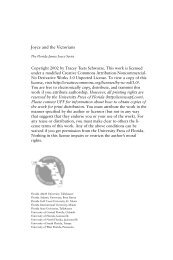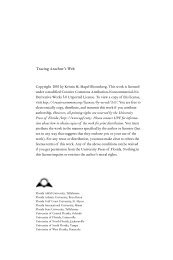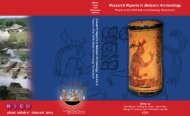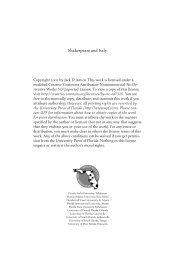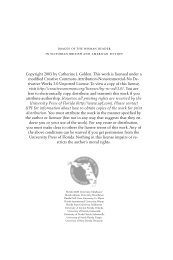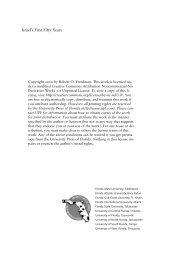Bernard Shaw's Remarkable Religion: A Faith That Fits the Facts
Bernard Shaw's Remarkable Religion: A Faith That Fits the Facts
Bernard Shaw's Remarkable Religion: A Faith That Fits the Facts
You also want an ePaper? Increase the reach of your titles
YUMPU automatically turns print PDFs into web optimized ePapers that Google loves.
A Playwright’s Progress 81<br />
horror or scandal actually occurred, that real people are shedding real<br />
blood and real tears, is indispensable to <strong>the</strong>ir enjoyment. (1190)<br />
So Zola indulged in a particular kind of illusionism in order to reach his<br />
audience, but it meant that he had to add extraneous sensational elements<br />
to his fiction, even though such abnormalities were not part of his real<br />
business, which was to convey general, and genuinely scientific, truths.<br />
Shaw sought to reach a different audience, one whose views of <strong>the</strong> world<br />
were shaped by <strong>the</strong> playhouse. He naturally chose, as Martin Meisel abundantly<br />
demonstrated, to adapt <strong>the</strong> familiar forms and conventions of <strong>the</strong><br />
contemporary <strong>the</strong>ater. He still had to give his audiences <strong>the</strong> truth as he saw<br />
it and convince <strong>the</strong>m it was indeed true. His first attempts were not fully<br />
satisfactory. Strindberg observed that whenever what Shaw called scientific<br />
natural history was simply poured into <strong>the</strong> old dramatic forms, “<strong>the</strong><br />
new wine has burst <strong>the</strong> old bottles” (395). The development of a new form,<br />
sufficiently familiar to be recognized and enjoyed but robust enough to<br />
convey <strong>the</strong> strong new potion, meant <strong>the</strong> evolution of a distinctive Shavian<br />
style.<br />
Shaw was thus sympa<strong>the</strong>tic to <strong>the</strong> first of <strong>the</strong> contradictions that ensnared<br />
naturalism because he recognized that it arose from <strong>the</strong> need to<br />
make unpalatable truths pleasant or interesting enough to be swallowed.<br />
<strong>That</strong> Zola sought to achieve that end through a kind of illusionism that<br />
Shaw ra<strong>the</strong>r conspicuously avoided is important only if one makes <strong>the</strong><br />
mistake of believing that illusions are <strong>the</strong> essence and purpose of realism.<br />
Zola’s “police intelligence” illusionism and Shaw’s <strong>the</strong>atricalism have <strong>the</strong><br />
same purpose: to engage <strong>the</strong> audience. They are different sugarcoatings for<br />
<strong>the</strong> pill of realism.<br />
The second contradiction concerns <strong>the</strong> true heart of realism as both<br />
Shaw and Zola understood it. George Becker points out that<br />
<strong>the</strong> basic ideal of <strong>the</strong> movement was and is rigorous objectivity; in<br />
spite of this it was almost impossible not to take a position, at least<br />
implicitly, about man and his fate, particularly since <strong>the</strong> whole climate<br />
of thought in which realism flourished was one of scientism. As<br />
Arthur McDowall says, “Realism in art undoubtedly refers us back to<br />
a physical, existing reality,” which is anterior to and independent of<br />
<strong>the</strong> individual mind. It is sceptical of . . . <strong>the</strong> events which escape <strong>the</strong><br />
o<strong>the</strong>rwise ineluctable laws of causality. It is this last term which is<br />
<strong>the</strong> key to <strong>the</strong> realist position: <strong>the</strong> universe is observably subject to



